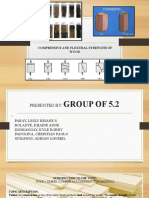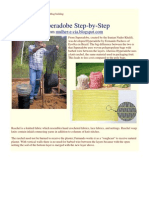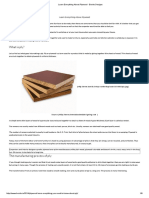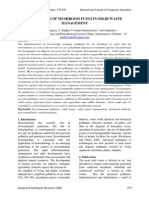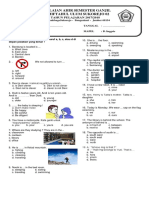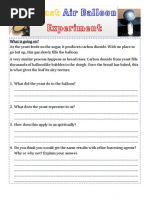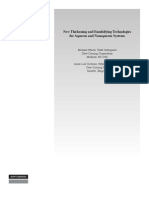Making Recycled Paper: Celebrating Chemistry
Making Recycled Paper: Celebrating Chemistry
Uploaded by
Nicholas SabadCopyright:
Available Formats
Making Recycled Paper: Celebrating Chemistry
Making Recycled Paper: Celebrating Chemistry
Uploaded by
Nicholas SabadOriginal Title
Copyright
Available Formats
Share this document
Did you find this document useful?
Is this content inappropriate?
Copyright:
Available Formats
Making Recycled Paper: Celebrating Chemistry
Making Recycled Paper: Celebrating Chemistry
Uploaded by
Nicholas SabadCopyright:
Available Formats
Making Recycled Paper from Celebrating Chemistry
D id you ever wonder where
paper comes from? Paper is
usually made from trees. To make
Procedure
1. Cut a piece of newspaper that
is 30 centimeters (12 inches)
paper, wood from trees is ground wide and 40 centimeters
into very small fibers called wood (15 inches) long.
pulp. The wood pulp is then washed 2. Rip the paper into small
with water, and pressed into paper pieces that are about 1
sheets. Every year, people in the centimeter (1⁄2 inch) square,
United States use more than 750 and place the pieces into
pounds of paper each! To produce a bowl.
that much paper, a 100-foot tall
tree would have to be cut down for 3. Add 1⁄2 cup water to the
each person. Luckily, about 75% of bowl and set it aside for 6. Using the plastic fork, strain
the paper used in the United States two days. the pulp and drop it onto the
today is recycled. (Source: Georgia (Alternatively, you can add the nylon screen in the needle
Pacific) To recycle your own paper, water and paper to a blender work frame. Then spread the
follow the simple steps below. or food processor. An adult pulp evenly across the surface
must complete all steps of the screen.
involving the blender or food 7. Carefully, remove the nylon
Materials processor! After the lid has screen from the frame and
Newspaper
been fastened securely onto place it pulp side up onto a
Blunt-end scissors
the appliance, the water pile of newspaper.
Ruler
mixture should be blended on
Bowl 8. Place the second piece of
medium speed for 5 minutes.
Measuring cup nylon screen over the pulp,
Skip to step 5.)
Water so that you make a sandwich
Blender or food processor (optional 4. Using a plastic fork, mix the with screen on top and
with adult supervision) paper with the water until the bottom and the pulp in the
Disposable plastic fork paper disintegrates into pulp. middle.
2 Pieces of nylon screen 5. Stretch one piece of the nylon
(30 cm, or 1 foot square each) screen into the needlework
Plastic needlework frame frame.
(15 cm, or 6 inch round)
Rolling pin
Hairdryer (optional)
Safety First!
SAFETY: Be sure to follow Milli’s
Safety Tips! Do not eat or drink any 9. Use the rolling pin to squeeze
of the materials used in this activity. all of the water out of the
An adult must do all the steps pulp by rolling it over the top
involving the blender or food of the nylon screens.
processor.
American Chemical Society © 2008
ww.acs.org/kids
Recycled Paper Page 2
10. Without removing the screens, Try this… Where’s the Chemistry?
move your newly formed Make a second batch of recycled Plants use the energy of the sun
paper to a dry spot, and paper adding in a few pieces of to make all sorts of chemicals like
allow it to dry overnight. colored paper, yarn or string to the sugars and complex carbohydrates.
(Alternatively, you can dry the newspaper. You can also add small One of these complex carbohydrates
paper using a hair dryer. An pieces of leaves or grass to change is called cellulose. Cellulose is
adult must perform this step.) the texture of the paper. tough and indigestible. It is the
main ingredient in wood pulp.
11. Remove the paper from the
Plants use cellulose to make their
nylon screens.
limbs and trunks strong and stiff.
12. Pour the liquids down the Without it, they would not be able
drain, recycle any unused to stand. Cellulose can be made
paper, and throw everything into many different products like
else in the trash. Thoroughly paper, cardboard, rayon fabric,
clean your work area, and and insulation. By recycling paper
wash your hands. we cut down on the amount of
waste in our landfills, save trees,
and conserve energy.
What Did You Observe?
What does your paper look like? Is it white? Why not?
American Chemical Society © 2008
www.acs.org/kids
Science Activities for Children from the American Chemical Society
The American Chemical Society develops materials for elementary school age children to
spark their interest in science and teach developmentally appropriate chemistry concepts.
The Activities for Children collection includes hands-on activities, articles, puzzles, and
games on topics related to children’s everyday experiences.
The collection can be used to supplement the science curriculum, celebrate National
Chemistry Week, develop Chemists Celebrate Earth Day events, invite children to give
science a try at a large event, or to explore just for fun at home.
Find more activities, articles, puzzles and games at www.acs.org/kids.
Safety Tips
This activity is intended for elementary school children under the direct supervision of an
adult. The American Chemical Society cannot be responsible for any accidents or injuries
that may result from conducting the activities without proper supervision, from not specifically
following directions, or from ignoring the cautions contained in the text.
Always:
• Work with an adult.
• Read and follow all directions for the activity.
• Read all warning labels on all materials being used.
• Wear eye protection.
• Follow safety warnings or precautions, such as wearing gloves or tying back long hair.
• Use all materials carefully, following the directions given.
• Be sure to clean up and dispose of materials properly when you are finished with an
activity.
• Wash your hands well after every activity.
Never eat or drink while conducting an experiment, and be careful to keep all of the materials
used away from your mouth, nose, and eyes!
Never experiment on your own!
For more detailed information on safety go to www.acs.org/education and click on
“Safety Guidelines”.
©2008 American Chemical Society
www.acs.org/kids
You might also like
- Roof Garden Specs 2019Document12 pagesRoof Garden Specs 2019CraigNo ratings yet
- Module 5 Compressive and Flexural Strength of Wood NewDocument31 pagesModule 5 Compressive and Flexural Strength of Wood NewEUREKA JANAH MENDOZANo ratings yet
- Occurrence of Pathogenic and Potentially PathogenicBacteria in Microgreens, Sprouts, and Sprouted Seedson Retail Market in Riga, LatviaDocument9 pagesOccurrence of Pathogenic and Potentially PathogenicBacteria in Microgreens, Sprouts, and Sprouted Seedson Retail Market in Riga, LatviakoriatsuNo ratings yet
- Morel CultivationDocument1 pageMorel Cultivationvas2000No ratings yet
- N MiskinDocument91 pagesN MiskinluciameauNo ratings yet
- 8353 Basic Microgreens Starter Kit 6960 Tech SheetDocument1 page8353 Basic Microgreens Starter Kit 6960 Tech SheetKen JoknNo ratings yet
- Earthbag Dome - BuildingDocument6 pagesEarthbag Dome - BuildingNatBangorNo ratings yet
- Making Wooden LegosDocument5 pagesMaking Wooden LegoscagedraptorNo ratings yet
- Wood Forming TechniqueDocument13 pagesWood Forming TechniqueLawal OlanrewajuNo ratings yet
- Microgreens Webinar CommentsDocument18 pagesMicrogreens Webinar CommentsNaveen KumarNo ratings yet
- Wood BookDocument63 pagesWood BookGNC AHŞAPNo ratings yet
- Recycle Cardboard Into Anything With 3D Printing!: InstructablesDocument23 pagesRecycle Cardboard Into Anything With 3D Printing!: Instructablesthedots technologiesNo ratings yet
- Adhesive Bonding of WoodDocument129 pagesAdhesive Bonding of WoodJOSEANTONIO2001No ratings yet
- Green Guide GrowingDocument138 pagesGreen Guide GrowingtheomatheoNo ratings yet
- Literature Review of Worms in Waste Management: Volume 2Document33 pagesLiterature Review of Worms in Waste Management: Volume 2Pennsylvania Association for Sustainable AgricultureNo ratings yet
- Advanced Technology PalletsDocument56 pagesAdvanced Technology PalletsHady MajorNo ratings yet
- Green Hotel InteriorsDocument31 pagesGreen Hotel InteriorsAlfonse TranNo ratings yet
- Types of StonesDocument8 pagesTypes of StonesAshu JainNo ratings yet
- Reuse of RubberDocument3 pagesReuse of RubberGanesh ShivaleNo ratings yet
- Good Stoves Facilitation: How to Innovate and Change the WorldFrom EverandGood Stoves Facilitation: How to Innovate and Change the WorldNo ratings yet
- Ywy8m Extreme Howto Holiday 2013Document67 pagesYwy8m Extreme Howto Holiday 2013José Carlos Alves Nogueira100% (1)
- Solar BuildingsDocument39 pagesSolar BuildingsSumit SahuNo ratings yet
- Timber Press Fall 2015 CatalogDocument76 pagesTimber Press Fall 2015 CatalogTimber PressNo ratings yet
- Geodome LSNDocument3 pagesGeodome LSNVidican Laura FlorinNo ratings yet
- Product 1: Flipper-Sweeper Equipments: Technical DetailsDocument11 pagesProduct 1: Flipper-Sweeper Equipments: Technical DetailsstranfirNo ratings yet
- Study On The Strength of EarthbagsDocument28 pagesStudy On The Strength of EarthbagsZherrinore Rasay100% (1)
- Top 8 Advantages and Challenges of Straw Bale ConstructionDocument6 pagesTop 8 Advantages and Challenges of Straw Bale ConstructionJogie Biarca DoteNo ratings yet
- Finishing Essentials: Technique CollectionDocument12 pagesFinishing Essentials: Technique CollectionNGAMIJENo ratings yet
- Bamboo Fiber & It'S Processing: by Amol V. Talware (Final T.C.)Document27 pagesBamboo Fiber & It'S Processing: by Amol V. Talware (Final T.C.)Aditya Bhansali100% (2)
- Mechanical Design of Smart Solar Tunnel DryerDocument5 pagesMechanical Design of Smart Solar Tunnel DryerashisbhuniyaNo ratings yet
- Bio-Based SolventsFrom EverandBio-Based SolventsFrançois JérômeNo ratings yet
- GCSE Woods Paper & Card TheoryDocument6 pagesGCSE Woods Paper & Card TheoryMissparish8No ratings yet
- Pulp & PaperDocument42 pagesPulp & PaperGautam SharmaNo ratings yet
- Wood PPTDocument41 pagesWood PPTY SAHITH100% (1)
- Plywood PDFDocument4 pagesPlywood PDFaulad999No ratings yet
- Push Operated Spray Pump Cum Fertilizer Spreader Initial ReportDocument35 pagesPush Operated Spray Pump Cum Fertilizer Spreader Initial ReportAditu50% (2)
- Bamboo Based Biocomposites Material, Design and ApplicationsDocument30 pagesBamboo Based Biocomposites Material, Design and ApplicationsGia Han Hoang HuuNo ratings yet
- Gardening With Composts, Mulches, & Row Covers Gardening Guidebook For Umatilla County, OregonDocument4 pagesGardening With Composts, Mulches, & Row Covers Gardening Guidebook For Umatilla County, OregonWinter GardeningNo ratings yet
- Natural Paint RecipesDocument9 pagesNatural Paint Recipeskinley dorjeeNo ratings yet
- Bioplastic Recipes IngredientsDocument8 pagesBioplastic Recipes IngredientsLatika Sharma100% (1)
- The Cob Solar Oven: Oriol BalliuDocument15 pagesThe Cob Solar Oven: Oriol BalliuMaulana Rizky SuradirjaNo ratings yet
- Special Woods and Wood AlternativesDocument61 pagesSpecial Woods and Wood AlternativesnadiajmiNo ratings yet
- Light Weight Gypsum BoardDocument9 pagesLight Weight Gypsum BoardVictor MelloNo ratings yet
- Amaranth To Zai Holes ECHODocument90 pagesAmaranth To Zai Holes ECHOsolarbobkyNo ratings yet
- Advance Construction and MaterialsDocument23 pagesAdvance Construction and MaterialsSaki Saki SakiNo ratings yet
- How To Survive A Lightning StrikeDocument5 pagesHow To Survive A Lightning StrikeSherryNo ratings yet
- Hemp Fiber Earth Blocks: September 2017Document9 pagesHemp Fiber Earth Blocks: September 2017CarinaNDMotaNo ratings yet
- Straw Bale Green HomeDocument13 pagesStraw Bale Green Homedanut_docNo ratings yet
- Ece Complete Book of Woodworking ToolsDocument33 pagesEce Complete Book of Woodworking ToolsRutger Hermens100% (2)
- Window Putty and PaintDocument17 pagesWindow Putty and PaintPaul SavvyNo ratings yet
- Hyperadobe (Passo A Passo)Document15 pagesHyperadobe (Passo A Passo)Vander De Almeida Candido50% (2)
- Learn Everything About Plywood - Bonito DesignsDocument8 pagesLearn Everything About Plywood - Bonito DesignsFiky SanjayaNo ratings yet
- Introducing IRIS Autopot Systems™: Home Businesses Products & Solutions ContactDocument1 pageIntroducing IRIS Autopot Systems™: Home Businesses Products & Solutions ContactAlbyziaNo ratings yet
- 10 Step Guide To Wood FinishDocument25 pages10 Step Guide To Wood FinishLuiz ImprovizzaNo ratings yet
- Syntesis of Silica XerogelDocument4 pagesSyntesis of Silica XerogelBrandon ArceNo ratings yet
- Application of Mushroom Fungi in Solid Waste ManagementDocument7 pagesApplication of Mushroom Fungi in Solid Waste ManagementIntegrated Intelligent Research100% (1)
- Microgreens Growing Guide PDF Cheat SheetDocument1 pageMicrogreens Growing Guide PDF Cheat SheetNspirati onNo ratings yet
- MDF (Medium Density Fibreboard) Made by A Process Which Glues WoodDocument3 pagesMDF (Medium Density Fibreboard) Made by A Process Which Glues WoodJensenNo ratings yet
- Fabric Science Assignment 1 On "Hemp" & "Bamboo" Cohesiveness PropertyDocument10 pagesFabric Science Assignment 1 On "Hemp" & "Bamboo" Cohesiveness PropertyaadishNo ratings yet
- 2 - Unit 04-06Document3 pages2 - Unit 04-06yjinter01No ratings yet
- Structure 2Document7 pagesStructure 2AhmadKhudhoibiNo ratings yet
- FWPS Vol 2 No 1 Paper 7Document20 pagesFWPS Vol 2 No 1 Paper 7030338220156No ratings yet
- Concept of Ecology and Ecosystem PresetationDocument58 pagesConcept of Ecology and Ecosystem PresetationPRASANT KUMAR BIPRA100% (1)
- Aseptic Packaging "" A Novel Technology To The Food IndustryDocument4 pagesAseptic Packaging "" A Novel Technology To The Food IndustryEditor IJTSRDNo ratings yet
- 20 Soal Reading BintaraDocument7 pages20 Soal Reading BintaraYolandaNo ratings yet
- The Diamond As Big As The Ritz: F. Scott FitzgeraldDocument11 pagesThe Diamond As Big As The Ritz: F. Scott Fitzgeraldrita44No ratings yet
- Biochem CHODocument67 pagesBiochem CHOanthealu_6pinkNo ratings yet
- Menu Sehari EnteralDocument5 pagesMenu Sehari EnteralMaylinda MustikaNo ratings yet
- Wake Up / Get Up Wash The FaceDocument12 pagesWake Up / Get Up Wash The FaceMyat Hsu PanNo ratings yet
- Business-Plan Twilight AromaDocument67 pagesBusiness-Plan Twilight Aromafrenzy olisNo ratings yet
- 101 All Natural Testosterone Boosters BonusDocument115 pages101 All Natural Testosterone Boosters BonusJD50% (4)
- Chemistry Project To Study The Adulterants in FoodDocument10 pagesChemistry Project To Study The Adulterants in FoodAshis karmakarNo ratings yet
- Soal UAS Bahasa Inggris Kelas 6 Semester 1Document2 pagesSoal UAS Bahasa Inggris Kelas 6 Semester 1Miftahul Ulum100% (3)
- ChakhchoukhaDocument1 pageChakhchoukhaanikeitNo ratings yet
- EXP 2 RancidityDocument6 pagesEXP 2 RancidityNur SyahirahNo ratings yet
- Lesson 3 BAKING INGREDIENTSDocument35 pagesLesson 3 BAKING INGREDIENTSMa. Rochelle CabralesNo ratings yet
- Feeding ManagementDocument23 pagesFeeding ManagementjustsoarermoonNo ratings yet
- Genetic Variability, Heritability and Genetic Advance in Potato (Solanum Tuberosum L.) For Processing Quality, Yield and Yield Related TraitsDocument9 pagesGenetic Variability, Heritability and Genetic Advance in Potato (Solanum Tuberosum L.) For Processing Quality, Yield and Yield Related TraitsPremier PublishersNo ratings yet
- Dps 2Document32 pagesDps 2byronic_heroNo ratings yet
- Yeast Air Balloon Experiment Data SheetsDocument2 pagesYeast Air Balloon Experiment Data SheetsSigalitChana100% (1)
- 8th Worksheet n2Document15 pages8th Worksheet n2Daniela Soledad Schroeder AlvialNo ratings yet
- Good Food Org GuideDocument76 pagesGood Food Org GuideFood Tank100% (4)
- The Wonderful Power of Charisma - Maurice BenoitDocument54 pagesThe Wonderful Power of Charisma - Maurice BenoitGary TuckerNo ratings yet
- Group 1. Stem DDocument58 pagesGroup 1. Stem Dlenard adiaNo ratings yet
- Moon Beverages LTDDocument17 pagesMoon Beverages LTDVaibhav Agarwal100% (1)
- Doctor FishDocument39 pagesDoctor Fishzagad04No ratings yet
- Thicken ErDocument8 pagesThicken Ertahir54No ratings yet
- Home Economics Mid TermDocument3 pagesHome Economics Mid TermReshma MohabeirNo ratings yet
- Watershed MGT and PlanningDocument10 pagesWatershed MGT and PlanningEr Jogendra SorenNo ratings yet

